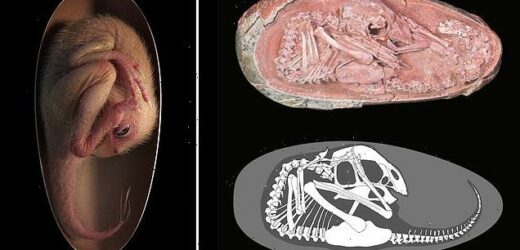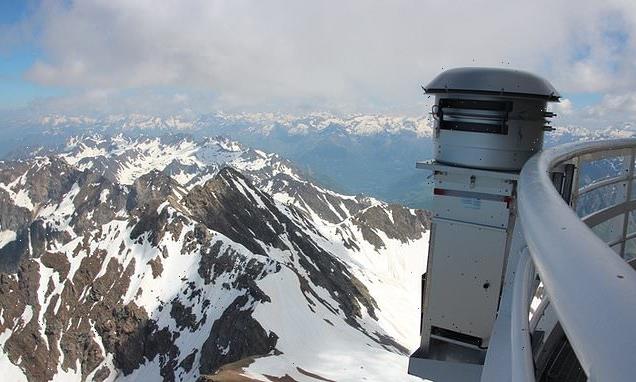Meet ‘Baby Yingliang’: Exquisitely preserved dinosaur embryo is discovered inside a 72 million-year-old fossilised EGG in China
- The fossil was first unearthed in the Shahe Industrial Park in Ganzhou City
- It belonged to a species of oviraptorosaur — toothless, beaked theropod dinos
- Baby Yingliang is one of the most complete dinosaur embryos known to science
- Its posture is closer to those seen in embryonic birds than normal for dinosaurs
- The find suggests that the behaviour, called tucking, likely arose in theropods
An exquisitely preserved dinosaur embryo has been found curled up inside a fossilised egg, unearthed in southern China, dating back some 66–72 million years.
The embryo has been dubbed ‘Baby Yingliang’ and was found in the rocks of the ‘Hekou Formation’ at the Shahe Industrial Park in Ganzhou City, Jiangxi Province.
Palaeontologists led from the University of Birmingham said that Baby Yingliang belonged to species of toothless, beaked theropod dinosaurs, or ‘oviraptorosaurs’.
Oviraptors, which were feathered, are found in the rocks of Asia and North America and had varied beaks and body sizes allowing them to adopt a wide range of diets.
The specimen is one of the most complete dino embryos known and notably sports a posture closer to those seen in embryonic birds than usually found in dinosaurs.
Specifically, Baby Yingliang was close to hatching, and had its head below its body, its back curled into the egg’s blunt end and its feet positioned either side of it.
In modern birds, such a posture is assumed during ‘tucking’ — an embryo behaviour controlled by the central nervous system that is critical for a successful hatching.
The discovery of such behaviour in Baby Yingliang suggests that this is not unique to birds, but may instead have first evolved among the non-avian theropod dinosaurs.
Scroll down for video
An exquisitely preserved dinosaur embryo has been found curled up inside a fossilised egg (pictured), unearthed in southern China, dating back some 66–72 million years
Palaeontologists led from the University of Birmingham said that Baby Yingliang (depicted in this artist’s impression) belonged to species of toothless, beaked theropod dinosaurs
BABY YINGLIANG STATISTICS
Age: 72–66 million years old
Locality: Ganzhou City, China
Type: Oviraptorosaur
Length: 10.6” (27 cm) head-to-tail
Egg size: 6.7” (17 cm) -long
The study was conducted by vertebrate palaeontologist Fion Waisum Ma of the University of Birmingham and her colleagues.
‘Dinosaur embryos are some of the rarest fossils and most of them are incomplete with the bones dislocated,’ Ms Ma said.
‘We are very excited about the discovery of “Baby Yingliang” — it is preserved in a great condition and helps us answer a lot of questions about dinosaur growth and reproduction with it.
‘It is interesting to see this dinosaur embryo and a chicken embryo pose in a similar way inside the egg, which possibly indicates similar prehatching behaviours.’
Baby Yingliang takes its nickname from the Yingliang Stone Nature History Museum in Xiamen, among whose fossil collections it is held.
The researchers believe that the embryonic oviraptorosaur would have been some 10.6 inches (27 cm) from head to tail, but was developing curled inside a 6.7 inch (17 cm) -long egg.
‘This dinosaur embryo was acquired by the director of Yingliang Group, Mr Liang Liu, as suspected egg fossils around the year 2000,’ said paper author and palaeontologist Lida Xing of the China University of Geosciences in Beijing.
‘During the construction of Yingliang Stone Nature History Museum in the 2010s, museum staff sorted through the storage and discovered the specimens.
‘These specimens were identified as dinosaur egg fossils. Fossil preparation was conducted and eventually unveiled the embryo hidden inside the egg.
‘This is how “Baby Yingliang” was brought to light.’
The specimen is one of the most complete dino embryos known and notably sports a posture closer to those seen in embryonic birds than usually found in dinosaurs. Specifically, Baby Yingliang — who was close to hatching — had its head below its body, its back curled into the egg’s blunt end and its feet positioned either side of it
‘It is interesting to see this dinosaur embryo (pictured) and a chicken embryo pose in a similar way inside the egg, which possibly indicates similar prehatching behaviours,’ said vertebrate palaeontologist Fion Waisum Ma of the University of Birmingham
‘This dinosaur embryo inside its egg is one of the most beautiful fossils I have ever seen,’ said paper co-author and vertebrate palaeontologist Steve Brusatte of the University of Edinburgh.
‘This little prenatal dinosaur looks just like a baby bird curled in its egg, which is yet more evidence that many features characteristic of today’s birds first evolved in their dinosaur ancestors.’
The full findings of the study were published in the journal iScience.
The embryo — which has been dubbed ‘Baby Yingliang’ — was found in the rocks of the ‘Hekou Formation’ at the Shahe Industrial Park in Ganzhou City, Jiangxi Province
HOW THE DINOSAURS WENT EXTINCT AROUND 66 MILLION YEARS AGO
Dinosaurs ruled and dominated Earth around 66 million years ago, before they suddenly went extinct.
The Cretaceous-Tertiary extinction event is the name given to this mass extinction.
It was believed for many years that the changing climate destroyed the food chain of the huge reptiles.
In the 1980s, paleontologists discovered a layer of iridium.
This is an element that is rare on Earth but is found in vast quantities in space.
When this was dated, it coincided precisely with when the dinosaurs disappeared from the fossil record.
A decade later, scientists uncovered the massive Chicxulub Crater at the tip of Mexico’s Yucatán Peninsula, which dates to the period in question.
Scientific consensus now says that these two factors are linked and they were both probably caused by an enormous asteroid crashing to Earth.
With the projected size and impact velocity, the collision would have caused an enormous shock-wave and likely triggered seismic activity.
The fallout would have created plumes of ash that likely covered all of the planet and made it impossible for dinosaurs to survive.
Other animals and plant species had a shorter time-span between generations which allowed them to survive.
There are several other theories as to what caused the demise of the famous animals.
One early theory was that small mammals ate dinosaur eggs and another proposes that toxic angiosperms (flowering plants) killed them off.
Source: Read Full Article







